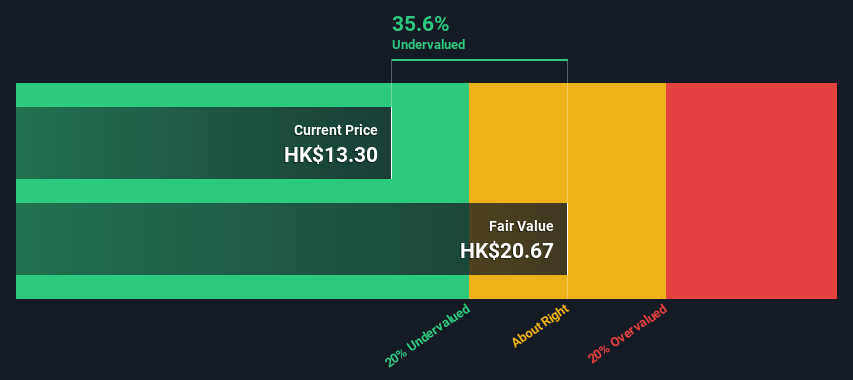- Hong Kong
- /
- Tech Hardware
- /
- SEHK:1810
Xiaomi Corporation's (HKG:1810) Intrinsic Value Is Potentially 55% Above Its Share Price

Key Insights
- The projected fair value for Xiaomi is HK$20.67 based on 2 Stage Free Cash Flow to Equity
- Xiaomi is estimated to be 36% undervalued based on current share price of HK$13.30
- The CN¥18.48 analyst price target for 1810 is 11% less than our estimate of fair value
Today we'll do a simple run through of a valuation method used to estimate the attractiveness of Xiaomi Corporation (HKG:1810) as an investment opportunity by taking the forecast future cash flows of the company and discounting them back to today's value. We will use the Discounted Cash Flow (DCF) model on this occasion. It may sound complicated, but actually it is quite simple!
We generally believe that a company's value is the present value of all of the cash it will generate in the future. However, a DCF is just one valuation metric among many, and it is not without flaws. For those who are keen learners of equity analysis, the Simply Wall St analysis model here may be something of interest to you.
View our latest analysis for Xiaomi
What's The Estimated Valuation?
We use what is known as a 2-stage model, which simply means we have two different periods of growth rates for the company's cash flows. Generally the first stage is higher growth, and the second stage is a lower growth phase. In the first stage we need to estimate the cash flows to the business over the next ten years. Where possible we use analyst estimates, but when these aren't available we extrapolate the previous free cash flow (FCF) from the last estimate or reported value. We assume companies with shrinking free cash flow will slow their rate of shrinkage, and that companies with growing free cash flow will see their growth rate slow, over this period. We do this to reflect that growth tends to slow more in the early years than it does in later years.
Generally we assume that a dollar today is more valuable than a dollar in the future, and so the sum of these future cash flows is then discounted to today's value:
10-year free cash flow (FCF) estimate
| 2024 | 2025 | 2026 | 2027 | 2028 | 2029 | 2030 | 2031 | 2032 | 2033 | |
| Levered FCF (CN¥, Millions) | CN¥18.7b | CN¥21.9b | CN¥28.1b | CN¥32.3b | CN¥35.9b | CN¥38.9b | CN¥41.4b | CN¥43.5b | CN¥45.3b | CN¥46.9b |
| Growth Rate Estimate Source | Analyst x6 | Analyst x5 | Analyst x1 | Est @ 14.94% | Est @ 11.05% | Est @ 8.32% | Est @ 6.42% | Est @ 5.08% | Est @ 4.15% | Est @ 3.50% |
| Present Value (CN¥, Millions) Discounted @ 9.3% | CN¥17.1k | CN¥18.4k | CN¥21.5k | CN¥22.6k | CN¥23.0k | CN¥22.8k | CN¥22.2k | CN¥21.3k | CN¥20.3k | CN¥19.2k |
("Est" = FCF growth rate estimated by Simply Wall St)
Present Value of 10-year Cash Flow (PVCF) = CN¥208b
The second stage is also known as Terminal Value, this is the business's cash flow after the first stage. For a number of reasons a very conservative growth rate is used that cannot exceed that of a country's GDP growth. In this case we have used the 5-year average of the 10-year government bond yield (2.0%) to estimate future growth. In the same way as with the 10-year 'growth' period, we discount future cash flows to today's value, using a cost of equity of 9.3%.
Terminal Value (TV)= FCF2033 × (1 + g) ÷ (r – g) = CN¥47b× (1 + 2.0%) ÷ (9.3%– 2.0%) = CN¥649b
Present Value of Terminal Value (PVTV)= TV / (1 + r)10= CN¥649b÷ ( 1 + 9.3%)10= CN¥266b
The total value, or equity value, is then the sum of the present value of the future cash flows, which in this case is CN¥474b. To get the intrinsic value per share, we divide this by the total number of shares outstanding. Compared to the current share price of HK$13.3, the company appears quite undervalued at a 36% discount to where the stock price trades currently. The assumptions in any calculation have a big impact on the valuation, so it is better to view this as a rough estimate, not precise down to the last cent.

The Assumptions
We would point out that the most important inputs to a discounted cash flow are the discount rate and of course the actual cash flows. If you don't agree with these result, have a go at the calculation yourself and play with the assumptions. The DCF also does not consider the possible cyclicality of an industry, or a company's future capital requirements, so it does not give a full picture of a company's potential performance. Given that we are looking at Xiaomi as potential shareholders, the cost of equity is used as the discount rate, rather than the cost of capital (or weighted average cost of capital, WACC) which accounts for debt. In this calculation we've used 9.3%, which is based on a levered beta of 1.214. Beta is a measure of a stock's volatility, compared to the market as a whole. We get our beta from the industry average beta of globally comparable companies, with an imposed limit between 0.8 and 2.0, which is a reasonable range for a stable business.
SWOT Analysis for Xiaomi
- Earnings growth over the past year exceeded the industry.
- Debt is not viewed as a risk.
- No major weaknesses identified for 1810.
- Annual revenue is forecast to grow faster than the Hong Kong market.
- Trading below our estimate of fair value by more than 20%.
- Annual earnings are forecast to grow slower than the Hong Kong market.
Next Steps:
Although the valuation of a company is important, it shouldn't be the only metric you look at when researching a company. DCF models are not the be-all and end-all of investment valuation. Instead the best use for a DCF model is to test certain assumptions and theories to see if they would lead to the company being undervalued or overvalued. For example, changes in the company's cost of equity or the risk free rate can significantly impact the valuation. Why is the intrinsic value higher than the current share price? For Xiaomi, we've compiled three additional aspects you should further research:
- Risks: For instance, we've identified 1 warning sign for Xiaomi that you should be aware of.
- Future Earnings: How does 1810's growth rate compare to its peers and the wider market? Dig deeper into the analyst consensus number for the upcoming years by interacting with our free analyst growth expectation chart.
- Other Solid Businesses: Low debt, high returns on equity and good past performance are fundamental to a strong business. Why not explore our interactive list of stocks with solid business fundamentals to see if there are other companies you may not have considered!
PS. The Simply Wall St app conducts a discounted cash flow valuation for every stock on the SEHK every day. If you want to find the calculation for other stocks just search here.
New: AI Stock Screener & Alerts
Our new AI Stock Screener scans the market every day to uncover opportunities.
• Dividend Powerhouses (3%+ Yield)
• Undervalued Small Caps with Insider Buying
• High growth Tech and AI Companies
Or build your own from over 50 metrics.
Have feedback on this article? Concerned about the content? Get in touch with us directly. Alternatively, email editorial-team (at) simplywallst.com.
This article by Simply Wall St is general in nature. We provide commentary based on historical data and analyst forecasts only using an unbiased methodology and our articles are not intended to be financial advice. It does not constitute a recommendation to buy or sell any stock, and does not take account of your objectives, or your financial situation. We aim to bring you long-term focused analysis driven by fundamental data. Note that our analysis may not factor in the latest price-sensitive company announcements or qualitative material. Simply Wall St has no position in any stocks mentioned.
About SEHK:1810
Xiaomi
An investment holding company, provides hardware and software services in Mainland China and internationally.
Flawless balance sheet with reasonable growth potential.


